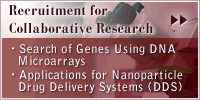Overview of Research
Integration of Life Sciences with Nanotechnology/Materials Science
Our challenge is to apply beneficial technologies to society by integrating original biological discoveries with original materials technologies and nanotechnology. The integration of life sciences and nanotechnology/materials science has two approaches. The first approach is to link critical knowledge in the life sciences to technological innovations through the use of nanotechnology and materials science. The other approach is to use nanotechnology and materials science to lead to important discoveries in the life sciences. To accomplish research using these two approaches, we are using the following foundational technologies.
Technologies Necessary to Research
1.Foundational Technologies in Life Sciences
①Global gene expression analysis
To obtain clues about important biological knowledge, we are carrying out global gene expression analysis using DNA microarrays. With this analysis, we have obtained data on the expression of about 22,000 genes. From these data, we obtain important information by using a variety of algorithms. Our group is also applying global gene expression analysis using DNA microarrays to the evaluation of biomaterials.
②Analysis of Mutual Interactions between Proteins
Many proteins form complex networks to mutually interact with other proteins and exhibit functions. We study what kinds of proteins the products of genes discovered by global gene expression analysis interact with and what are the mechanisms used to exhibit their functions.
③Bioimaging
This technology allows visualization of the interactions and localizations of proteins and the behaviors of proteins when they functionalize. We can use information on temporal and spatial changes in the function of a protein for feedback into the design of materials.
2.Foundational Technologies in Materials Science and Nanotechnology
①Surfaces Technology
This technology is used to create surfaces with various nano-micro structures, protein surfaces with different electrical charges, protein surfaces with different hydrophilicity, etc.
②Nanoparticles/Nanotubes Technology
This technology is used to create hollow mesoporous silica nanoparticles with controlled particle size and mesopore diameter to control cell functions. It is also used to create products such as mesoporous silica nanotubes.
Research Topics
1.Discovery Genomics
| A. | Our research seeks to discover membrane proteins that become differentiation markers of osteoblasts by performing c global gene expression analysis using microarrays. Our research also seeks to isolate osteoblasts differentiated from stem cells and use them in regenerative medicine. We are also evaluating the performance of artificial bones by using the genes of these membrane proteins as indicator. |
| B. | We are searching for genes involved in diseases by collaborating in research with a variety of institutions. In collaboration with project leader Satoshi Koike of the Tokyo Metropolitan Institute of Medical Science, we have discovered the receptor of EV71, a virus that causes foot-and-mouth disease. |
2.Application of Toll-Like Receptor 9 (TLR9)’s CpG Recognition Mechanism to the Prevention of Pollen Allergy
| A. | TLR9 binds with a variety of DNA, but signal transduction occurs only when CpG binds with it. We are studying how TLR9 recognizes CG sequences in a chain of oligo-DNA (ODN). |
| B. | It has been suggested that the activation of TLR9 is effective for the treatment of various allergies, such as hay fever. But even if CpG, a ligand, were administered to activate TLR9, CpG would be dissolved easily by nucleases inside the body, leading to an undesired result. We are conducing research on searching for new ODN, which has higher activity than previously known CpG sequences, and is stable inside the body. We are also studying nanoparticles to transport the ODN. |
3.Molecular Mechanisms Involved in Cell Toxicity of Nanoparticles
In recent years, products that include nanoparticles have increased drastically in recent years. However, no standards have been established concerning the safety of nanoparticles. From global gene expression analysis of cells exposed to nanoparticles, we are elucidating molecular mechanisms involved in nanoparticles’ cellular toxicity.
4.Observation of Temporal and Spatial Changes in Apoptosis-Induced Proteins and Applications Toward Biomaterials
It has been suggested that the formation of microdomains is important for apoptosis-induced signals via the binding of Fas and FasL. We are conducting research to elucidate the role of the formation of microdomains in apoptosis induction by observing the actions during formation of Fas – FasL complex, and to apply our findings to the development of materials that control the formation of microdomains.

